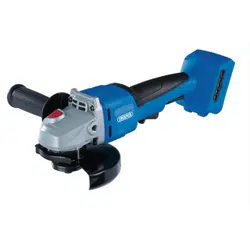Loading ...
Loading ...
Loading ...

–
5
–
k) Keep bystanders a safe distance away from
work area. Anyone entering the work area
must wear personal protective equipment.
Fragments of workpiece or of a broken
accessory may y away and cause injury
beyond immediate area of operation.
l) Position the cord clear of the spinning
accessory. If you lose control, the cord may
be cut or snagged and your hand or arm may
be pulled into the spinning accessory.
m) Never lay the power tool down until the
accessory has come to a complete stop.
The spinning accessory may grab the surface
and pull the power tool out of your control.
n) Do not run the power tool while carrying it
at your side. Accidental contact with the
spinning accessory could snag your clothing,
pulling the accessory into your body.
o) Regularly clean the power tool’s air vents.
The motor’s fan will draw the dust inside the
housing and excessive accumulation of
powdered metal may cause electrical hazards.
p) Do not operate the power tool near
ammable materials. Sparks could ignite
these materials.
q) Do not use accessories that require liquid
coolants. Using water or other liquid coolants
may result in electrocution or shock.
Further safety instructions for all operations
Kickback and related warnings
Kickback is a sudden reaction to a pinched or snagged
rotating wheel, sanding band, brush or any other
accessory. Pinching or snagging causes rapid stalling of
the rotating accessory which in turn causes the
uncontrolled power tool to be forced in the direction
opposite of the accessory’s rotation.
For example, if an abrasive wheel is snagged or pinched
by the workpiece, the edge of the wheel that is entering
into the pinch point can dig into the surface of the
material causing the wheel to climb out or kick out. The
wheel may either jump toward or away from the operator,
depending on direction of the wheel’s movement at the
point of pinching. Abrasive wheels may also break under
these conditions.
Kickback is the result of power tool misuse and/or
incorrect operating procedures or conditions and can be
avoided by taking proper precautions as given below.
a) Maintain a rm grip on the power tool and
position your body and arm to allow you to
resist kickback forces. The operator can
control kickback forces, if proper precautions
are taken.
b) Use special care when working corners,
sharp edges etc. Avoid bouncing and
snagging the accessory. Corners, sharp
edges or bouncing have a tendency to snag
the rotating accessory and cause loss of
control or kickback.
c) Do not attach a toothed saw blade. Such
blades create frequent kickback and loss of
control.
d) Always feed the bit into the material in the
same direction as the cutting edge is
exiting from the material (which is the
same direction as the chips are thrown).
Feeding the tool in the wrong direction causes
the cutting edge of the bit to climb out of the
work and pull the tool in the direction of this
feed.
e) When using rotary les, cut-off wheels,
high-speed cutters or tungsten carbide
cutters, always have the work securely
clamped. These wheels will grab if they
become slightly canted in the groove, and can
kickback. When a cut-off wheel grabs, the
wheel itself usually breaks. When a rotary le,
high-speed cutter or tungsten carbide cutter
grabs, it may jump from the groove and you
could lose control of the tool.
Safety Warnings Specic for Grinding and Abrasive
Cutting-Off Operations:
a) Use only wheel types that are
recommended for your power tool and the
specic guard designed for the selected
when. Wheels for which the power tool was
not designed cannot be adequately guarded
and are unsafe
b) The grinding surface of centre depressed
wheels must be mounted below the plane
of the lip guard. An improperly mounted
when that projects through the plane of the
guard lip cannot be adequately protected.
c) The guard must be securely attached to
the power tool and positioned for
maximum safety, so the least amount of
wheel is exposed towards the operator.
The guard helps to protect the operator from
broken wheel fragments, accidental contact
with wheel and sparks that could ignite
clothing.
d) Wheels must be used only for
recommended applications. For example:
do not grind with the side of the cut-off
wheel. Abrasive cut-off wheels are intended
for peripheral grinding, side forces applied to
these wheels may cause them to shatter.
e) Always use undamaged wheel anges that
are of correct size and shape for your
selected wheel. Proper wheel anges
support the wheel thus reducing the possibility
of wheel breakage. Flanges for cut-off wheels
may be different from grinding wheel anges.
f) Do not use worn down wheels from larger
Loading ...
Loading ...
Loading ...
